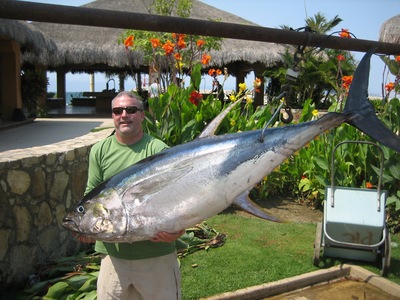June 24, 2011
Strange week, the first week of summer felt more like winter or early spring. Persistent cold winds from the south swept in cooler currents, dropping water temperatures to 68 to 72 degrees through much of the Southern Baja coastal stretches. Murky green conditions were spread out to over 20 miles offshore, though the dirty current did not reach past Los Frailes. The season's second Hurricane, Beatriz, developed off Southern Mexico, this system weakened over land, before encountering cooler waters and dissipating as fast as it had developed. Beatriz was several hundred miles south of Cabo San Lucas, it was packing winds to 90 mph, enough to create larger swells that did pound Southern Baja beaches for several days. Now we patiently wait, It is only matter of time before the conditions turn back around, but it is hard to say exactly when this will happen.
As conditions drastically changed, the week started off with a wide spread die off of fish being reported. First observed north of Punta Gorda and then in the direction of Palmilla and Cabo San Lucas. Masses of mostly smaller sized snapper species, one pound or less, deeper water specimens, a few larger fish, no dead pelagic species reported. When talking with local residents they cannot remember ever witnessing a similar incident. In most cases these fish were found floundering on the surface, barely alive, before eventually dying and drifting onto the beaches.
Of course many theories have surfaced as to what might have caused this event, among them being by catch from commercial netting, poison red tide, natural occurrence, nuclear fallout from Japan, drastic current/temperature change, air bladder rupture, limited oxygen levels and terrorist poison attack. Biologists have collected specimens for study, but we have not yet heard any reports as to a confirmed cause. The die off occurred for the first part of the week and seems to have abated.
Anyway, we do know that we had an extreme current and temperature change in a matter of 24 hours, water temperature had been in the 81 to 83 degree range and when this south westerly current swept in the water temp dropped to a chilly 68 degrees, also turned over to dirty murky green. So we are just passing around many theories, waiting to hear any information from the biologists. I personally think it has something to do with such a drastic change, deep current lacking sufficient oxygen.
Anglers found extremely difficult fishing this past week, southern wins were persistent, at times gusting to 30 mph in the afternoon. Finding clean water was the main problem, high surf conditions stirred up the inshore action even more. Larger baitfish were available from the commercial fleet, but finding any hungry fish to hit the bait was the hard game. A few roosterfish, jack crevalle or skipjack provided what little action was found, more numbers of roosters were found near Vinorama and to the north, which is a very long distance from any local launch sites. Local panga fleets did not find any wahoo, dorado or tuna where they had the previous week. Charters that ventured 20 to 30 miles offshore did report scattered action on some medium sized yellowfin tuna and an occasional dorado or marlin, but with choppy seas you were wise to be on a larger sized sportfisher to venture that far out.
Striped marlin were scattered throughout the area, as water cleans we expect them to be very hungry. On Thursday there was an encouraging report from a sportfisher that caught and released half dozen stripers from the Gordo Banks area, they found this action after having retuned from as far as 30 miles offshore, where they had seen no signs of life.
The combined panga fleets launching from La Playita/Puerto Los Cabos sent out approximately 51 charters for the week, with anglers reporting a fish count of: 1 striped marlin, 3 dorado, 7 yellowfin tuna, 6 amberjack, 3 yellowtail, 18 pargo, 44 roosterfish, 32 jack crevalle, 11 cabrilla, 22 skipjack and 5 sierra.
Good fishing, Eric

